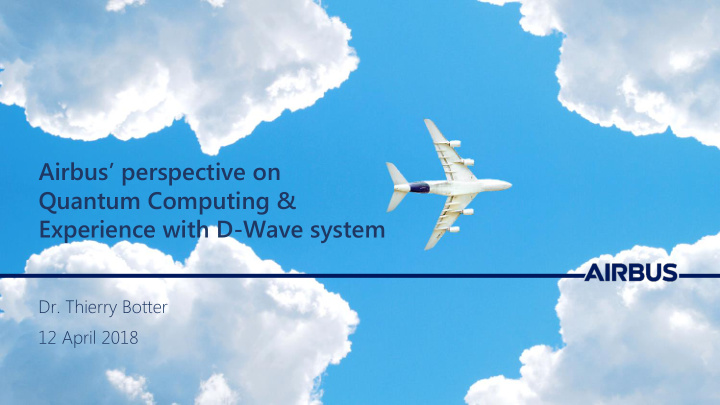



Airbus’ perspective on Quantum Computing & Experience with D-Wave system Dr. Thierry Botter 12 April 2018
We are a worldwide leader in aeronautics, space and related services : We make it fly!
Airbus by numbers (end of 2017) Airbus (Group) Revenue Airbus Defence and Space 66,800 M€ Airbus Helicopters 75% Airbus Order Book Product & Next- Aircrafts Delivered EBIT Employees gen R&D expenses in 2017: 950,354 M€ 3,428 M€ 133,782 2,011 M€ 718 7,265 A/C
Airbus & High Performance Computing TOP500 PFlops Long history of deploying large HPC clusters : #1 TOP500 29 th position, 1 st among industries in 2011 [1] TFlops AIRBUS #500 GFlops Most use-cases focus on computationally 1993 1996 1999 2002 2005 2008 2011 2014 heavy simulations for engineering & design (i.e. CFD, FEM, aeroacoustics, aeroelasticity, flight & system simulations, …) [1] https://www.top500.org/site/47306
Airbus & High Performance Computing Airbus’ investment level into HPC activities: Near-term IT solutions: ~3% of IT budget , with main focus on • Airbus IT scaling up methods & tools for industrial production; Long-term research activities: ~1% of R&D budget. • HPC R&D focused on extending the HPC toolset: cloud, distributed, multi- platform (x86/ARM/GPU) … and quantum computing! HPC activities run as collaborative projects between internal engineers & Airbus external partners to bridge aerospace problems and HPC platforms R&D Only one relevant metric : HPC Does a technology provide Airbus with a demonstrated performance improvement in addressing a specific challenge? *not to scale
Airbus & Quantum Computing Quantum Computing (QC) is being investigated as a possible extension to the HPC toolset. Open questions for Airbus: Can QC contribute to known HPC challenges? How? • What HPC performance can be achieved with today’s QC at reduced problem • sizes? How do performances scale with problem size? How can we prepare ourselves for a QC future? What’s the operational & • business impact? When is the right time to invest in preparations?
Quantum Computing @ Airbus Why? When? How? What?
Gateway to Quantum Computing Apply HPC philosophy to QC : leverage external ecosystem in tandem with internal experts to investigate potential applications to Airbus needs. Strategic investment : Airbus became a seed investor in QC Ware in 2016. The marriage allowed Airbus to enter the space of Quantum Computing and have an expert partner to help explore the various corners of the space, across different QC hardware technologies and different aerospace applications.
Hardware Agnostic Airbus is indifferent to the type of quantum hardware implementation / vendor, and whether any system is truly quantum or not. The only determining factor is the demonstrated performances of these systems on relevant Airbus applications / business propositions. First QC project conducted with D-Wave 2000Q machine.
First QC investigation: Fault Tree Analyses What? Top Event Fault Trees or Dependence Diagrams represent the connection points between sub-systems and nodes in large, complex Intermediate engineering structures. Fault Tree Analyses (FTAs) investigate the event combination of local failures that result in global system failures, often with mission safety implications. Applications Fault trees are relevant across many aerospace systems, including Basic aircraft, spacecraft and vehicle fleets. They are an integral part of event qualification and certification processes. First QC investigation focused on FTAs for aircraft. Why? NP-hard problem to compute all possible failure modes, and identify combination of failures that can lead to the safety critical top-event (i.e. loss of system function). QC is known to have potential benefits for this type of problem. *MMEL: Minimum Mandatory Equipment List 12/04/2018 10
First QC investigation: Fault Tree Analyses Airbus typical problem • QC hardware: 2000-qubit D-Wave machine. The quantum annealer could handle FTAs with up to ~300 events+gates. QA • Benchmark against commercial SAT solver Run Time (sec) shows competitive performance as timing does not seem to be related to problem size • Potential hybrid approach: find the shortest minimal cut-sets using QA, followed by a classical computation for the full fault-tree current software calculation. Predicted 4x reduction of runtime. solution not to scale Events+Gates in Tree 12/04/2018 11
First QC investigation: Fault Tree Analyses Increased QC familiarity • Project enabled Airbus experts to get first experience in applied QC. • QC Ware led technical work: translate FTAs into QUBO (language amenable to quantum annealers), program and run FTAs on D-Wave 2000Q machine, benchmarking against SAT solver. Impactful results • Results demonstrated promise in an important area of Airbus’ business. • Airbus additionally motivated to continue research on QC because of FTA results. Lessons learnt • Work through nomenclature and mathematical framework, incl. terms for consistency checks, early in project – develop a common language between aerospace and QC worlds.
Airbus & QC in the future Airbus remains interested in the promise of QC. More projects to come! The QC strategy in short: Hands-on experience through partnerships with external startups & • key players to evaluate selected HPC use-cases. Continuous evaluation of available technology & trends, to adapt • investment strategy accordingly . Raise awareness within the Airbus HPC community and continue to • research candidate use-cases.
Recommend
More recommend